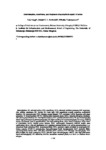Determination, occurrence, and treatment of saccharin in water: A review
| dc.contributor.author | Pang, L | |
| dc.contributor.author | Borthwick, Alistair | |
| dc.contributor.author | Chatzisymeon, E | |
| dc.date.accessioned | 2021-08-22T10:56:41Z | |
| dc.date.available | 2021-08-22T10:56:41Z | |
| dc.date.issued | 2020-10 | |
| dc.identifier.issn | 0959-6526 | |
| dc.identifier.other | 122337 | |
| dc.identifier.uri | http://hdl.handle.net/10026.1/17649 | |
| dc.description.abstract |
Saccharin (SAC) is an emerging contaminant, widely detected in the environment, with potential ecotoxicity risks to aqueous organisms and human beings. Wastewater treatment plants (WWTPs) are key sources and sinks of SAC, and play a vital role in eliminating SAC entering the environment. An overview is provided of the potential ecotoxicity of SAC, its occurrence in the aqueous environment, and its degradation performance in WWTPs. SAC treatments, including physical, chemical (mainly advanced oxidation processes AOPs), biological, and hybrid processes, and possible degradation mechanisms are also considered. Of the various SAC removal processes, we find that adsorption-based physical methods exhibit relatively poor performance in terms of SAC removal, whereas chemical methods, especially hydroxy radical-mediated oxidation processes, possess excellent capacities for SAC elimination. Although biological degradation can be efficient at removing SAC, its efficiency depends on oxygen supply and the presence of other co-existing pollutants. Hybrid aerobic biodegradation processes combined with other treatments including AOPs could achieve complete SAC reduction. Furthermore, novel adsorbents, sustainable chemical methods, and bioaugmentation technologies, informed by in-depth studies of degradation mechanisms and the metabolic toxicity of intermediates, are expected further to enhance SAC removal efficiency and enable comprehensive control of SAC potential risks. | |
| dc.format.extent | 122337-122337 | |
| dc.language | en | |
| dc.language.iso | en | |
| dc.publisher | Elsevier BV | |
| dc.subject | 7 Affordable and Clean Energy | |
| dc.title | Determination, occurrence, and treatment of saccharin in water: A review | |
| dc.type | journal-article | |
| dc.type | Review | |
| dc.type | Journal | |
| plymouth.volume | 270 | |
| plymouth.publication-status | Published | |
| plymouth.journal | Journal of Cleaner Production | |
| dc.identifier.doi | 10.1016/j.jclepro.2020.122337 | |
| plymouth.organisational-group | /Plymouth | |
| plymouth.organisational-group | /Plymouth/Faculty of Science and Engineering | |
| plymouth.organisational-group | /Plymouth/Faculty of Science and Engineering/School of Engineering, Computing and Mathematics | |
| plymouth.organisational-group | /Plymouth/Users by role | |
| plymouth.organisational-group | /Plymouth/Users by role/Academics | |
| dc.rights.embargoperiod | Not known | |
| rioxxterms.versionofrecord | 10.1016/j.jclepro.2020.122337 | |
| rioxxterms.licenseref.uri | http://www.rioxx.net/licenses/all-rights-reserved | |
| rioxxterms.type | Journal Article/Review |


